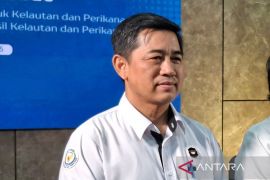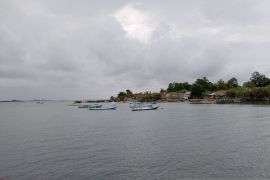President Susilo Bambang Yudhoyono and First Lady Ani Yudhoyono have announced their plan to visit North Sumatra on January 23, to visit the refugees of the volcano.
"The President and I plan to visit the refugees on January 23," stated Ani Yudhoyono recently.
She expressed her concern over the plight of the refugees who have been living in the shelter camps for months now, due to the erratic eruptions.
Mount Sinabung has been erupting on and off since September 2013, and even now there is no indication about when its volcanic activities will end, leaving thousands of refugees in limbo.
The eruption of the volcano located in Karo District, North Sumatra Province, has displaced at least 26,088 people, both Christians and Muslims across 34 villages and two hamlets.
When most Christians all over the world celebrated Christmas with their families at homes on December 25, 2013, as many as 18,412 refugees from the 2,457-meter-high Mount Sinabung eruption woke up to Christmas at refugee camps away from home.
They have been staying in refugee camps for four mounts now, with limited clean water and sanitary facilities. They have lost their homes, belongings, jobs and schools. Many of the refugees are reportedly suffering from stress.
Chairman of the Indonesian Red Cross and former vice president M Jusuf Kalla visited the Sinabung refugees on January 8, to coordinate for more relief aid for the victims. Some of the refugees expressed their need for cleaner water and vegetables.
Head of Data and Information Center of the National Disaster Mitigation Agency (BNPB) Sutopo Purwo Nugroho stated recently that the eruption-affected villagers have been taking refuge in 31 shelters such as Los Tiga Binanga, Payung church, Kabanjahe Great Mosque, Kabanjahe military dormitory, Jambur Natolu, Islamic Center and Los Tanjung Mbelang dan Los Tanjung Pulo.
To help the evacuees make a living, the authorities have arranged for cash fund through a program called "Cash for Work," wherein they can take up work, such as helping build sanitation, evacuation routes, etc., and get paid at Rp50 thousand per day. Each evacuee is allowed to join the program for a maximum of 20 days only.
BNPB has set aside Rp7.2 billion to the Karo District Administration for the Cash for Work program and for some equipment procurement.
Head of BNPB Syamsul Maarif explained that his agency donated Rp21 million as funds to aid the refugees. They also received Rp3.64 billion from the social affairs ministry and Rp1.55 billion from the North Sumatra provincial administration, Maarif added.
President Yudhoyono has instructed BNPB and the concerned ministries to intensify assistance to the eruption victims in North Sumatra, he stated.
According to Maarif, 16 refugees are reported to have died so far. However, their deaths were not directly linked to the eruptions since they had died of either some form of illness or of old age in refugee camps or in hospitals.
Mount Sinabung has been erupting sporadically, spewing massive clouds of superheated gas and ash as high as 7 thousand meters into the sky and down its slopes in deadly pyroclastic flows.
Maarif confirmed that the lava flood was threatening the inhabitants of several villages located in the downstream areas of rivers, into which the lava has flown.
The authorities raised the alert status for Sinabung to the highest level in November 2013. One of the recent series of eruptions occurred on January 14, with 30 eruptions recorded during the day.
The disaster mitigation agency has requested people not to indulge in any activities within seven kilometers radius of Mount Sinabung, because eruptions could be accompanied by ejection of materials within a radius of seven kilometers.
People living southeast of Mount Sinabung have been asked to evacuate in order to avoid possible casualty due to the lava stream and hot clouds in their areas.
Local Disaster Mitigation Agencies (BPBD) in Karo District and its neighboring Langkat District have distributed thousands of face masks to the refugees of Mount Sinabung eruption, to protect them from the thick ash and smoke that has permeated the atmosphere.
"We have re-distributed one thousand masks for the refugees in Telagah Village of Sei Bingei Sub-district due to the spreading of the ashes from Mt. Sinabung," informed Head of Langkat BPBD Hardianul Zally recently. The agency urged people to wear masks during any outdoor activity to avoid respiratory diseases.
Last December 2013, it was reported that 122 refugees in Karo District were ill and underwent treatment in several hospitals in the intensive care units, in Kabanjahe city, Medan.
Chairman of the Kabanjahe Media Center for Sinabung Disaster Management Post Jhonson Taringan informed that most of the refugees suffered from acute respiratory infection.
The eruption also caused damages to agricultural crops worth at least Rp1 trillion (almost US$90 billion), according to Head of the North Sumatra Agriculture Office HM Roem in Medan, the capital of North Sumatra Province, recently.
Up to December 18, the eruption damaged 29,885 hectares of agricultural areas in four sub-districts - Namanteran, Payung, Tiganderket, and Simpang Empat.
The affected crops included paddy, corn, sweet potato, taro, vegetables, fruits and ornamental plants.
Earlier, the last eruption of Mount Sinabung was in August 2010, after being considered to be inactive for about 400 years.
The 2010 eruption affected some domestic local flights, killed two and forced the evacuation of more than 18 thousand people living in the villages located within a six kilometer radius. ***3***
(f001/INE/o001)
Reporter: Fardah
Editor: Fardah Assegaf
Copyright © ANTARA 2014












